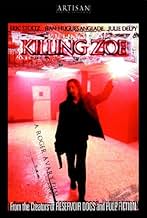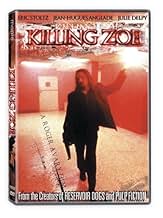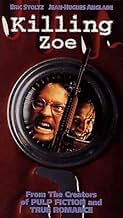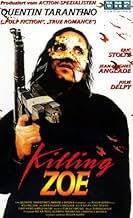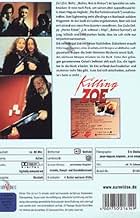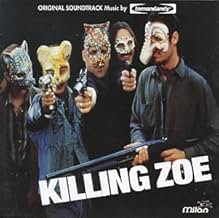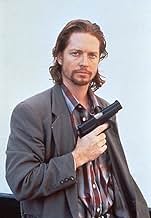The cab driver sets American Zed up with Zoe in his Paris hotel. Despite FFR1000 charged, she's an art student with day jobs e.g. bank. Safecracker Zed meets his junkie friend after 11 years... Read allThe cab driver sets American Zed up with Zoe in his Paris hotel. Despite FFR1000 charged, she's an art student with day jobs e.g. bank. Safecracker Zed meets his junkie friend after 11 years to rob a bank.The cab driver sets American Zed up with Zoe in his Paris hotel. Despite FFR1000 charged, she's an art student with day jobs e.g. bank. Safecracker Zed meets his junkie friend after 11 years to rob a bank.
- Awards
- 2 wins & 1 nomination total
Elise Renee
- Patchoo
- (as Elise Renée)
Ron Jeremy
- Concierge
- (as Ron Jeremy Hyatt)
Gian-Carlo Scandiuzzi
- Bank Manager
- (as Gian Carlo Scandiuzzi)
Gérard Bonn
- Assistant Bank Manager
- (as Gerard Bonn)
- Director
- Writer
- All cast & crew
- Production, box office & more at IMDbPro
Storyline
Did you know
- TriviaThe idea behind making the film actually came about when Lawrence Bender was scouting locations for Quentin Tarantino's Reservoir Dogs (1992). Bender found a great bank in downtown Los Angeles and informed Tarantino, who said that although the location was no good for Dogs, it would be good for a film set in a bank. Bender called every screenwriter he knew, asking if they had any scripts set in a bank. Roger Avary lied and said he did, then furiously wrote the first draft in under two weeks
- GoofsWhen the robbers are in the back of the van handing out the masks, Eric is handed the same mask twice.
- Crazy creditsThe characters, events and institutions depicted in this motion picture are fictional. Any similarity to actual persons or junkies, living or dead, is purely coincidental.
- Alternate versionsOriginally rated "NC-17", some graphic scenes of violence was trimmed to be re-rated "R".
- ConnectionsEdited from Nosferatu: A Symphony of Horror (1922)
Featured review
Eric Stoltz plays a man named Zed who travels to Paris in order to catch up with a childhood friend named Eric (Jean-Hugues Anglade) and help him rob a Federal Reserve bank. Upon his arrival, he sleeps with a call girl named Zoe (Julie Delpy) who he ends up falling in love with. When Zed goes to meet Eric, he ends up spending the night with him and all of his junkie friends who hide out in a run down apartment building with a dead feline near the entrance to their room. They plan to rob the bank the next morning, and Zed is going to be the safe cracker. After much passing out, puking, hallucinating, and a male rape, Zed and the rest of the gang awaken in a drunken daze, already late for their robbery, and then they foolishly attempt to rob the bank while still moderately trashed, hungover, and restless. Naturally things go very wrong very fast, and it becomes no longer about getting the money, but more about trying to survive.
If Roger Avary's intention was to make a truly memorable art house exploitation film, he succeeded with flying colors. I'm pretty sure that this was intention and there's no denying that this is a good film. I have some serious problems with Killing Zoe, however, and those problems have much to do with the first two thirds of the picture. Avary spends a very large portion of the film in this junkie world with these truly atrocious and ugly characters doing ugly things. I felt that too much time was spent in this world. The only likable character is Julie Delpy's character, and she doesn't get nearly enough screen time as she should. As for Eric Stoltz, he pretty much plays the same character as he played in Pulp Fiction, though not anywhere near as much as a prick. His character, Zed, for the most part is a fairly goofy, eccentric, and slight perverted guy. I liked how he wasn't an entirely sympathetic protagonist. His character, for the most part, works. Likewise for his friend Eric, who is a completely horrific villain. He's disgusting, sleazy, skeletal-looking, and a sweaty mess of a man who has little conscience and no morals, and I applaud Jean-Hugues Anglade for playing a role that few actors would have the balls to play. This brings me to my biggest gripe with the film, however. These are the three main characters, but they are also the three most interesting characters as well. Every other character is completely disposable they take up far too much screen time that should have been devoted to the three main characters. To make matters worse, in the third act of the film when the characters actually try to rob the bank, a good portion of all of these characters are killed off almost immediately. While I applaud Roger Avary for crafting such a strong vision of graphic carnage in the third act, I felt that he was betraying the trash quality that took place in the first two acts with these junkie characters getting slaughtered so damn quickly. As the last act of the film stands, most of the characters end up getting killed off almost constantly and with little to no emotion. When it is not a member of the gang getting killed it is either a security guard or an innocent civilian. Somebody is almost always getting killed, often in over-the-top fashion.
What I did love about Killing Zoe was the look of the film. The bank that the film takes place in during the final act is just gorgeous in how claustrophobic it is. The walls of the bank are red, and it only adds to the psychotic nature of the Eric character. The character really is quite terrifying, and the bank that Avary shot in has a perfect interior for these sort of characters. The middle section mostly takes place in real grimy, dirty, dark areas that look completely hellish. Somehow the bank looks like a scarier location than the junkie hideouts, and I liked that. The opening and closing scenes show some beautiful shots of Paris as well, which definitely helped elevate the film even more. I also felt that the final act of the film, despite the gratuitous bloodshed and carnage, really was quite suspenseful and intense. The film is so furious in it's tone and the final act really pulls it all together. At times it is difficult to watch because the audience knows right away that the situation is going to go wrong and the characters are doomed. When the bank robbery actually starts, it is so disorganized and so uncoordinated that a feeling of unhinged maniacal danger sets in immediately. It makes the film a little bit different from other heist films. The characters are all young, hapless, and careless people who have abandoned reality.
Killing Zoe lacks a sense of control, which both helps and hurts the film. On one hand, it certainly helps make the final act of the film that much more shocking and realistic. On the other hand, it is difficult to look part the first two thirds of the film. I do think that this film has an audience, but I also think that it's difficult to call it a good film. It works in a lot of ways. Visually, it's better than it needs to be. The performances are all very strong, not to mention ballsy, and the vision of hell this film paints is pretty tough to shake. It's a rough film, but it manages to have a lot of energy. It is a very flawed film. However, if you're a fan of trash cinema and exploitation, you may want to give this a try. It's a messy film, but it's effective and definitely memorable.
If Roger Avary's intention was to make a truly memorable art house exploitation film, he succeeded with flying colors. I'm pretty sure that this was intention and there's no denying that this is a good film. I have some serious problems with Killing Zoe, however, and those problems have much to do with the first two thirds of the picture. Avary spends a very large portion of the film in this junkie world with these truly atrocious and ugly characters doing ugly things. I felt that too much time was spent in this world. The only likable character is Julie Delpy's character, and she doesn't get nearly enough screen time as she should. As for Eric Stoltz, he pretty much plays the same character as he played in Pulp Fiction, though not anywhere near as much as a prick. His character, Zed, for the most part is a fairly goofy, eccentric, and slight perverted guy. I liked how he wasn't an entirely sympathetic protagonist. His character, for the most part, works. Likewise for his friend Eric, who is a completely horrific villain. He's disgusting, sleazy, skeletal-looking, and a sweaty mess of a man who has little conscience and no morals, and I applaud Jean-Hugues Anglade for playing a role that few actors would have the balls to play. This brings me to my biggest gripe with the film, however. These are the three main characters, but they are also the three most interesting characters as well. Every other character is completely disposable they take up far too much screen time that should have been devoted to the three main characters. To make matters worse, in the third act of the film when the characters actually try to rob the bank, a good portion of all of these characters are killed off almost immediately. While I applaud Roger Avary for crafting such a strong vision of graphic carnage in the third act, I felt that he was betraying the trash quality that took place in the first two acts with these junkie characters getting slaughtered so damn quickly. As the last act of the film stands, most of the characters end up getting killed off almost constantly and with little to no emotion. When it is not a member of the gang getting killed it is either a security guard or an innocent civilian. Somebody is almost always getting killed, often in over-the-top fashion.
What I did love about Killing Zoe was the look of the film. The bank that the film takes place in during the final act is just gorgeous in how claustrophobic it is. The walls of the bank are red, and it only adds to the psychotic nature of the Eric character. The character really is quite terrifying, and the bank that Avary shot in has a perfect interior for these sort of characters. The middle section mostly takes place in real grimy, dirty, dark areas that look completely hellish. Somehow the bank looks like a scarier location than the junkie hideouts, and I liked that. The opening and closing scenes show some beautiful shots of Paris as well, which definitely helped elevate the film even more. I also felt that the final act of the film, despite the gratuitous bloodshed and carnage, really was quite suspenseful and intense. The film is so furious in it's tone and the final act really pulls it all together. At times it is difficult to watch because the audience knows right away that the situation is going to go wrong and the characters are doomed. When the bank robbery actually starts, it is so disorganized and so uncoordinated that a feeling of unhinged maniacal danger sets in immediately. It makes the film a little bit different from other heist films. The characters are all young, hapless, and careless people who have abandoned reality.
Killing Zoe lacks a sense of control, which both helps and hurts the film. On one hand, it certainly helps make the final act of the film that much more shocking and realistic. On the other hand, it is difficult to look part the first two thirds of the film. I do think that this film has an audience, but I also think that it's difficult to call it a good film. It works in a lot of ways. Visually, it's better than it needs to be. The performances are all very strong, not to mention ballsy, and the vision of hell this film paints is pretty tough to shake. It's a rough film, but it manages to have a lot of energy. It is a very flawed film. However, if you're a fan of trash cinema and exploitation, you may want to give this a try. It's a messy film, but it's effective and definitely memorable.
Details
- Release date
- Countries of origin
- Languages
- Also known as
- Вбити Зої
- Filming locations
- Production companies
- See more company credits at IMDbPro
Box office
- Budget
- $1,500,000 (estimated)
- Gross US & Canada
- $418,961
- Opening weekend US & Canada
- $30,586
- Aug 21, 1994
- Gross worldwide
- $418,961
Contribute to this page
Suggest an edit or add missing content



